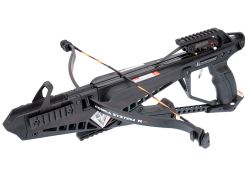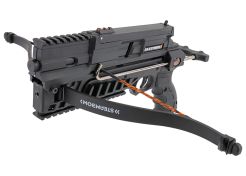So, what kind of crossbows are out there?
You can buy three types of crossbow in our store: pistol crossbows, recurve crossbows and compound crossbows. Let’s begin with the first:
- Pistol crossbows are light and compact crossbows without a stock, featuring just a pistol grip and sometimes a front grip. The crossbow arrows used are short and this makes them best suitable for shorter distances. But don’t let the compact size fool you, these little crossbows can be surprisingly powerful.
- Recurve crossbows are crossbows of which the end of the limbs are arching forwards. This’ll give a bigger preload, resulting in a greater speed for the crossbow arrows. The recurved shape of the limbs makes them so much more effective, that they can be made shorter compared to an equally powerful crossbow with conventional straight limbs. This means a recurve crossbow can be made more compact or, when kept the same size, is more powerful and faster.
- Compound crossbows have short, straight limbs with eccentric pulleys at the ends. The crossbow string has roughly three times the length of a normal bowstring and because of the pulley system, the limbs can be made incredibly stiff to generate a massive power. Where other crossbows require the most draw weight at the end of the pulling stroke, the string of a compound crossbow reaches its heaviest draw weight somewhere halfway, before getting lighter again, thanks to the eccentric pulleys leaving only a percentage of the maximum drawing weight at the end of the stroke, the so-called let-off. Take, for example, a 150 lbs compound crossbow with a let-off of 75%. After the initial 150 lbs are overcome, the draw weight reduces to 37.5 lbs. This generates less stress on the trigger mechanism, meaning less wear and a better sensitivity.
Cocking a crossbow: the right way
As a rule, cocking a crossbow takes a lot more effort than to draw a bow. The reason is simple: when drawing a bow, you need to hold it by hand at maximum tension while aiming, while a crossbow allows you to relax your muscles after cocking for a smooth aim before pulling the trigger. A crossbow therefore, can have a bigger draw weight, making it harder to cock. The power of a crossbow is usually displayed in lbs (English pounds) and the more lbs, the more speed a crossbow arrow will have and this speed is measured in fps (feet per second) of m/s (metres per second). The faster a crossbow arrow flies, the flatter its trajectory and the bigger its impact. For archery, the flat trajectory improves accuracy, but the heavy impact can drive crossbow arrows straight through the target or make them really hard to remove. For hunting however (where permitted), a big impact is actually very desirable and definitely advisable.
As said above, crossbows are usually very powerful, making cocking them hard work. Some crossbows can still be cocked by hand, but often a cocking aid is needed. There are four ways to cock a crossbow and no matter which one you use, you always need to put the safety off, so the trigger mechanism can work freely and engage.
- Cocking by hand has the advantage of being the quickest way to cock a crossbow. Make sure to mark the string with a marker, for example on both sides of the flight groove. This way you can make sure to pull back the string evenly. If you don’t, and end up pulling more with one hand than the other, your accuracy could suffer significantly. Always keep your foot firmly in the cocking stirrup, preventing the chance of the crossbow to bungee in your face and make sure the string has fully engaged the latch.
- Cocking with a cocking lever is something that is sometimes featured on pistol crossbows. The leverage helps to reduce the force needed to cock the crossbow. A cocking lever is normally situated at the back of the crossbow and it will pick up the string with a nock, pulling it into the latch. Make sure to push the front of the crossbow against the ground or firmly hold it and take care to positively engage the latch.
- Cocking with a cocking rope will reduce your cocking effort with at least 50%. A cocking rope has two handles and two hooks with pulleys that smoothly transport the rope, making sure the string stays centered. The hooks are attached to the bowstring and the piece of rope in between is pulled back and guided through a notch in the rear end of the crossbow. Now you can pull the handles evenly backwards, while keeping the crossbow firmly to the ground with your foot in the stirrup, making sure the string engages properly in the latch.
- Cocking with a cranking device is basically similar to cocking with a cocking rope, but instead of pulling handles with your hands, you now use a pre-mounted cranking device. This requires even less cocking effort, but does take the most time. As with all cocking methods, place your foot firmly in the stirrup and make sure the latch properly engages.
Be careful, it's life now!
Other than with a normal bow, where you nock the arrow when the string is in neutral position, it’s important to know a crossbow is life the moment it’s cocked. So before you even think of putting the crossbow arrow in position and risk your fingers if you accidentally stir the trigger, make sure to put the safety on if your crossbow has one. Place the crossbow arrow with one fletching/feather in the flight groove, so the other two are also free from obstructions. Only when you’ve correctly placed the crossbow arrow and are pointing in the direction of the target, you disengage the safety.
Never dry fire a crossbow
When a crossbow is cocked, never dry fire it, but always fire it with a crossbow arrow. The power is normally transferred into the crossbow arrow and is then converted into speed. Without an arrow, this power will fully return to the parts of the crossbow when it’s dry fired. This can result in micro fractures that’ll eventually mean the breaking of the parts. Decocking a crossbow is also never done by using the cocking rope or cranking device, as the powers are simply to high to risk slipping. The only way to decock a crossbow is by firing a crossbow arrow, so make sure you’re near a target or even a heap of sand before cocking a crossbow.
Accessories, take your pick!
When buying a crossbow, there will be some accessories you’ll need too. Not in the least some crossbow arrows, but you’ll also need a target pack and some target faces. And when your crossbow features a rail such as a Weaver/Picatinny or dovetail rail, you will also be able to mount a red dot or rifle scope.







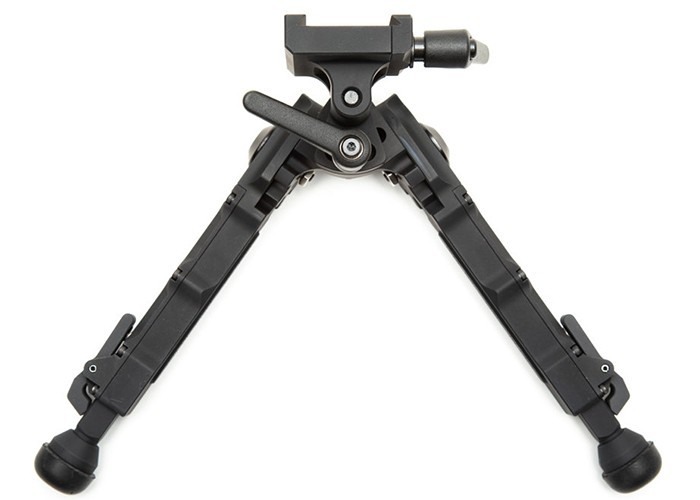







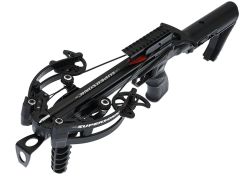


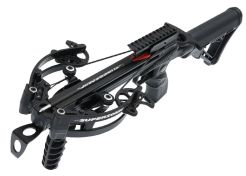



 Fast & secure delivery
Fast & secure delivery Secure shopping & payment
Secure shopping & payment Lots of expertise
Lots of expertise